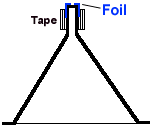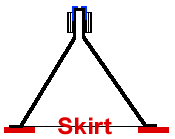| balloon
hovercraft |
|
Hovercrafts
ride suspended on a thin bubble of air. The main technical challenge
in building a hovercraft is to control the shape, flexibility and leakage
of that bubble. Too much air leaking out of the hovercraft will empty
the balloon air supply before the craft has a chance to slide along
the surface. Too little air, and the hovercraft will fail to rise
above the surface.
Simple
balloon hovercrafts are nothing more than a flat disk with a hole in
the center fed by the air from a balloon. As long as the disk sits on
a very flat surface it will skid along quite nicely on a very thin skin
of air. However, even a small piece of debris is sufficient to hold
the disk in place. Likewise, a dent in the table will bleed air out
from under the disk so quickly that the bubble of air collapses and
the hovercraft stops hovering.
Thus,
most real hovercrafts employ a flexible skirt along the bottom edge
of the air bubble. This skirt will yield when encountering debris, and
flows into dents and grooves to prevent air leakage. Even a simple balloon
hovercraft toy benefits from a flexible skirt.
Materials
list:
- A plastic
funnel, about 4" wide at the top. Find one with a flat lip around
the openning (as shown in this cross-sectional sketch)

- A thin
flexible sheet of plastic larger than the funnel. A vinyl or rubber
sheet works well, as will a thick piece of polyethylene sheeting or
even waxed paper.
- A 1"
square piece of heavy duty aluminum foil.
- A large
balloon- the bigger the better (one foot inflated does quite well).
- Double
stick tape
- Regular
tape
Instructions:
- Place
the aluminum foil on the neck of the funnel (if the neck has an angled
edge, rather than a flat tip perpendicular to the openning as shown,
use a sharp razor blade to re-cut it flat and perpendicular to the
neck. Needless to say, sharp knives can be dangerous (DUH!) so please
be carefull and ask for help if you are unsure of your guillotining
skills) Fold the edges of the foil down around the neck, sealing off
the funnel.

- Using
regular cellophane tape, wrap the sides of the neck to hold the foil
in place. Make sure this is an air tight seal. Also, keep wrapping
layers of tape around the diameter of the neck until it is large enough
that the balloon´s lip will fit tighly over the neck.
- Now
make the hovercraft skirt. Place the funnel on the sheet of plastic.
Trace around the funnel. Then, draw two circles around this ring -
the first about a 1/2" larger in diameter, and the second about 1/2"
smaller in diameter. Cut along these two new circles, forming a washer
shaped gasket.

- Cover
the bottom lip of the funnel with double stick tape. Use many 1´´
segments of tape. Make sure the tape is flat, and that each piece
of tape overlaps its neighbor to prevent leaks.
- Carefully
center the bottom of the hovercraft on the skirt. Press onto the skirt
and rub to adhere tightly. Trim off any double stick tape that extends
over the sides of the skirt.
- Using
a pencil, punch a small 1/16" hole in the center of the aluminum foil.
This small hole is called a "bleed valve", and controls the rate of
air leakage from the balloon.
- Inflate
the balloon. Stretch the balloon over the lip of the neck. And you´re
done!
Flying
Instructions:

- Place
the hovercraft on a flat, smooth surface (like a table or vinyl floor).
It should skim along effortlessly.
If the
hovercraft doesn´t hover:
- Sometimes
the skirt is sticky or wet. Make sure it is dry, or powder the bottom
of the skirt with flour.
- Make
sure the skirt is centered- if not one side may act as a pivot and
the hovercraft will spin in circles.
- If the
craft is too light, air will leak from under the skirt. Try adding
a few weights symetrically around the perimeter of the funnel - for
example, glue on a dozen pennies. If it is too heavy, open the hole
in the "bleed valve". You may find it easier to control the size of
the hole if you first put a strip of tape over the aluminum fail.
- Check
for leaks. Hold the hovercraft firmly against a smooth surface- no
air should leave the balloon.
|
|
|

Contact Greg Blonder by email here - Modified
Genuine Ideas, LLC.
|
|










